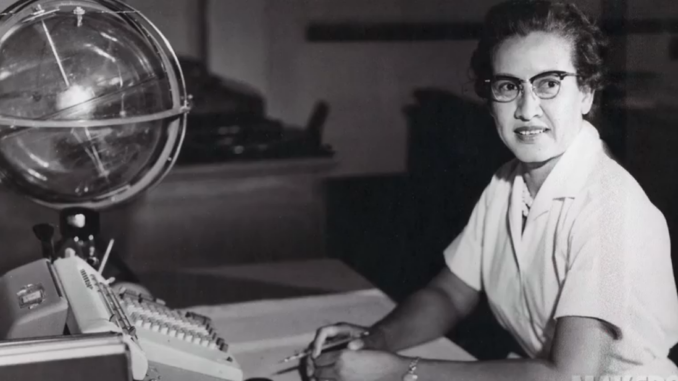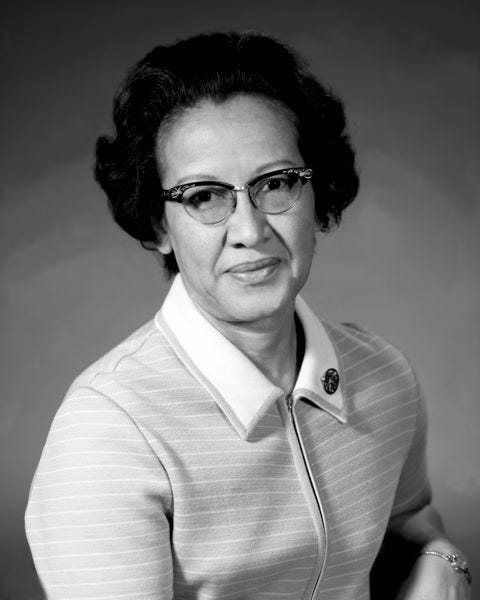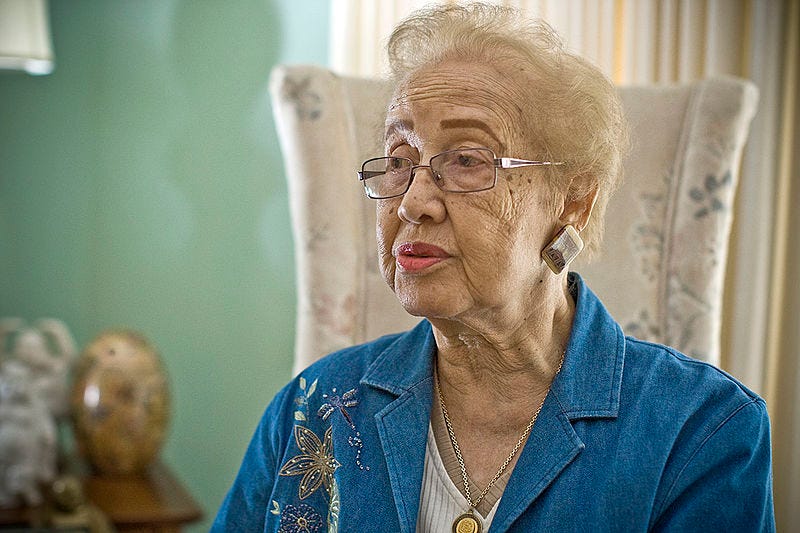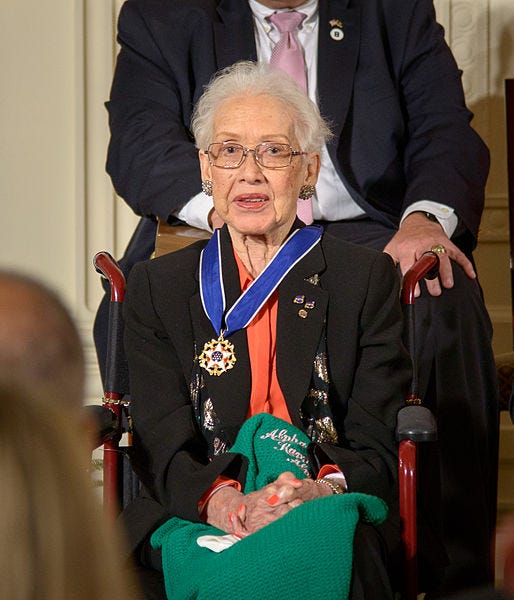Women in tech history: Katherine Johnson, the mathematician who guided us to the moon 🚀
This is the fourth article in a series about amazing women in tech history. The first featured Margaret Hamilton, the software engineer who helped land us on the moon. The second featured Grace Hopper, a programming pioneer and first woman to be a US Navy Admiral. The third featured the ENIAC programmers, who were pioneers ignored by history.
The women featured so far in this series have been white Americans. There are many more stories to tell and upcoming articles will feature women here in the UK and elsewhere abroad. For now we turn our attention to Katherine Johnson, an amazing woman who faced both gender and racial discrimination in pursuit of her passion. I chose to focus on Katherine in this article because I wonder how many people know that the trajectory for NASA’s first manned mission was calculated by an African American woman.

Photo: NASA
Katherine was born in August 26, 1918, which happens to be Women’s Equality Day in the US. Her family lived in West Virginia, where her father was a farmer and part-time janitor. Her mother was a teacher before having 4 children of which Katherine was the youngest. It was clear from a very young age that maths would become a huge part of Katherine’s life.
“I counted everything. I counted the steps to the road, the steps up to church, the number of dishes and silverware I washed… anything that could be counted, I did.”
Her father was desperate to get his children a decent education but had little choice at home; the local school wouldn’t teach African Americans beyond 8th grade. He had to send them to a school 125 miles away from their home. Teachers at the school were amazed at Katherine’s abilities not just with numbers but her reading skills. When she started school she skipped straight to 2nd grade and then later skipped 5th grade meaning she was a grade above some of her older siblings. This acceleration meant she started high school at the age of 10.
Towards the end of high school, Katherine was taught by Schiefflin Clayton who only the 3rd African American to earn a PhD in maths. He instantly recognised Katherine’s talents and love for astronomy. He created entire courses at the school just for Katherine, including analytic geometry, and she was usually the only pupil in these lessons. She finished high school and started college at the age of 14 and had completed a Bachelor of Science degree in maths and French by the time she was 18.
The height of segregation
Katherine wasn’t oblivious to racism growing up but hadn’t experienced the worst of it until she began working. Her first job was as a teacher but she had to travel to Virgina. Her mother warned her that things were worse there than in West Virginia and that she should be careful. Katherine responded, “Well, tell them I’m coming.”
Katherine’s story is one of personal strength. She once told NASA administrator Charles Boldon that she didn’t care too much about racism in her own life. “I didn’t have time for that… don’t have a feeling of inferiority. Never had. I’m as good as anybody, but no better.” Katherine grew up when segregation in the US was at its worst but it wasn’t something that could stop her doing what she wanted to do. She braved the segregated bus commutes and worked as a teacher for several years.

NASA
During World War II, there were shortages for scientists and engineers as many were fighting overseas. This led to the hiring of women mathematicians for important roles during the war. In 1941, Franklin D. Roosevelt signed an order to begin hiring more African Americans too. Two years later, the Langley Research Centre began hiring African American women who studied maths and chemistry to work as “human computers” in a research lab. In 1953, Katherine joined the women at Langley working for NACA, which would become NASA. Katherine didn’t escape racism by joining NASA; the employees were segregated and the reminders were always there. The lab itself was built over a former plantation.
Katherine was not alone when she joined; dozens of African American women worked at Langley as human computers, doing extremely complex calculations for a number of projects in the space race. The job paid better than many alternatives for educated women at the time ($2000 per year) but they were still discriminated against. At the research lab, the women were segregated in “coloured” work-spaces separate from the white women doing the exact same work. They were made to work a mile away from the other women and in facilities that didn’t even have a toilet. The white women were given accommodation nearby while Katherine and her colleagues had to make their own arrangements.
It’s important to note that although this is a story about the life of Katherine Johnson, many African American women contributed to NASA’s space programme as human computers. Most of the complex calculations required by the agency were provided by women and Katherine famously described this as a time when “the computer wore a skirt.” We celebrate the white men who landed on the moon, and rightly so, but rarely the countless women that helped make it happen. Many of those women were African Americans working during the height of segregation. They did their jobs well and helped NASA work with trajectories, analyse data from wind resistance tests, and figure out how spacecraft could re-enter the Earth’s atmosphere without burning up.
One small step
Katherine was respected for her calculations and was a prized member of her team. What made her stand out from everyone else was her questioning attitude. Others did what they were told but Katherine always needed to know more. When she was given new trajectories she would ask what they were for; she asked technical questions about the missions; she asked why the women were never invited to the meetings. It wasn’t long before she caught the eye of her supervisors.
One day she was taken into an all-male group temporarily to assist with calculations. She showed her expertise, asked questions, and they apparently “forgot” to send her back to the other women. She never looked back. Her expertise was calculating the trajectories of launches and where they would land.
“I’d ask ‘where do you want to come down?’ And they’d tell me the spot and I’d work backward form there.”
She was there for the Mercury missions in the 1950s-60s, the Apollo missions in the 1960s-70s, and the space shuttle missions in the 1980s. Her trajectories were used in many of NASA’s most historic achievements.

Photo: NASA/Sean Smith
In 1961, Alan Shephard became the first American in space (he’s also famous for hitting a golf ball on the moon) and Katherine calculated the trajectories to get him up there and safely back to Earth. Launches are complicated enough, taking into account things like weather conditions, but soon NASA had her working with orbits too. The following year, John Glenn was to become the first American to orbit the planet and again Katherine was behind the trajectories. For that mission NASA had started using computers for the first time but Katherine’s own calculations were still used to verify that the computers were accurate. The move to computers led to Katherine becoming a computer scientist as well as mathematician.
Katherine was a technical leader during the Apollo missions and played a pivotal role in America’s successful space race. Perhaps her greatest contribution was calculating the trajectories for Apollo 11, the mission that landed humans on the moon for the first time.
“I felt most proud of the success of the Apollo mission. They were going to the moon and I computed the path to get there.”
Later life
Katherine worked on space shuttle and satellite missions before finally retiring in 1986 after 33 years with NASA. During her career she was instrumental in many firsts including the moon landing but also contributed to NASA in more subtle ways. She created space textbooks for the agency; she created star maps that would allow astronauts to pilot themselves home in the event of electronics failures; she co-authored 26 scientific publications; she even contributed work for future missions to Mars.
In retirement, Katherine has been an incredible inspiration to young people and not just because of her past achievements. She has spent decades working with young people to encourage them to take up STEM careers. Over the years her efforts in the space race and in encouraging young people to take up STEM subjects has won her many awards and honorary degrees from universities. Last November, at the age of 97, President Obama awarded Katherine with America’s highest civilian honour: the Presidential Medal of Freedom.

Photo: NASA
Katherine is an inspiration to anyone with a passion. There were many forces in her life that made it difficult to pursue her passion but she overcame them all, including gender discrimination and racial segregation. She didn’t just keep her head down and do the work society expected her to; she wanted to work in a male-dominated field during a time of racial segregation in the US. Katherine believed that she was as good as anyone, “but no better.” Those who worked with her claim she was definitely better. NASA owes Katherine Johnson so much and she will always be a key figure in the history of space exploration.
This is the fourth article in a series about amazing women in tech history. The first featured Margaret Hamilton, the programming pioneer who helped land us on the moon. The second featured Grace Hopper, the programming pioneer who became the first woman to be a US Navy Admiral. The third featured the ENIAC programmers who were pioneers ignored by history. The next is about the women of Bletchley Park, who saved countless lives in WWII but were sworn to secrecy.